A Texan’s guide to your state government
This is a preview of our Texas 2036 newsletter diving deeper into the machinery of our state government — its state agencies. To receive this weekly look at our work, sign up here.
State Gov’t 101: What are Texas’ state agencies?

With a state as big as Texas, the need exists for an efficient state government that can respond to the needs of all Texans.
This week, we explain the structure, functions and key players in state government to give you a clearer picture of the agencies and state employees who provide Texans with essential services.
Texas state government: Powered by its employees

A total of 188 state entities employ a workforce of more then 341,000 full time equivalent (FTE) workers. The state workforce breaks down into two main categories, state agencies and institutions of higher education.
Texas has more state agencies but higher education accounts for more of the state’s workforce. Here are the numbers:
- 114 state agencies employ 140,584 FTEs
- 74 higher education institutions employ 200,721 FTEs
The five biggest state agencies in terms of workforce are:
 Essential Function:
Essential Function:
Administers social services programs such as Medicaid, the Children’s Health Insurance Program and food assistance programs like the Supplemental Nutrition Assistance Program and the Women, Infants, and Children program.
Annual Average FTEs for FY 2023: 34,198.6
% of State Agency Workforce: 24.3%
% of State Workforce: 10%
Source: FTE System, State Auditor’s Office
 Essential Function:
Essential Function:
Administers the state’s prison, jail and parole systems.
Annual Average FTEs for FY 2023: 29,749.9
% of State Agency Workforce: 21.2%
% of State Workforce: 8.7%
Source: FTE System, State Auditor’s Office
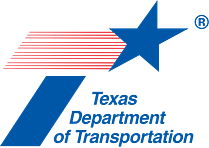 Essential Function:
Essential Function:
Administers construction and maintenance of the state’s highway system.
Annual Average FTEs for FY 2023: 12,910.4
% of State Agency Workforce: 9.2%
% of State Workforce: 3.8%
Source: FTE System, State Auditor’s Office
 Essential Function:
Essential Function:
Administers the state’s foster care system and investigates reports of abuse and neglect against children and the elderly.
Annual Average FTEs for FY 2023: 11,997.4
% of State Agency Workforce: 8.5%
% of State Workforce: 3.5%
Source: FTE System, State Auditor’s Office
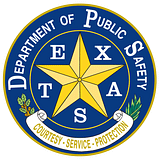 Essential Function:
Essential Function:
Administers statewide law enforcement and the issuing of driver’s licenses.
Annual Average FTEs for FY 2023: 10,177.7
% of State Agency Workforce: 7.2%
% of State Workforce: 3%
Source: FTE System, State Auditor’s Office
These five agencies account for more than 70% of the state agencies’ workforce.
Dive deeper into the 10 state agencies with the biggest workforce:
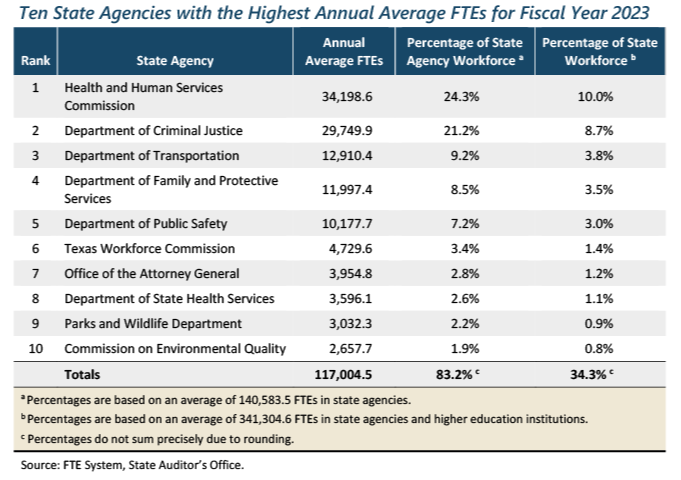
What is an FTE? The state counts the size of its workforce in “full time equivalents,” which represents the number of hours an employee works compared to the normal 40-hour workweek.
For example, one employee working the standard 40-hour workweek counts as one FTE but two employees who each work 20 hours a week is also counted as one FTE.
Yes, higher ed workers are considered state employees
 Source: The University of Texas MD Anderson Cancer Center
Source: The University of Texas MD Anderson Cancer Center
And among the state’s higher education institutions, it might surprise you to learn that five of the 10 with the biggest workforces are the University of Texas System’s medical schools and hospitals.
Houston’s MD Anderson Cancer Center alone has a workforce of nearly 23,600 FTEs!
Texas’ state employees: Pay is up, turnover down

More than 341,000 state employees fill a wide array of jobs, ranging from educators to law enforcement to administrative roles like determining eligibility for social services.
The workforce for Fiscal Year 2023 is up 4% from the previous fiscal year. The median salary for a Texas state government employee was $54,338. That’s about 21% less than the statewide average income of $68,744.
Do people who work for the state government stick around?
The statewide turnover rate in 2023 was 18.7% — down from 22.7% the previous year and nearly equalling the turnover rate recorded in 2020.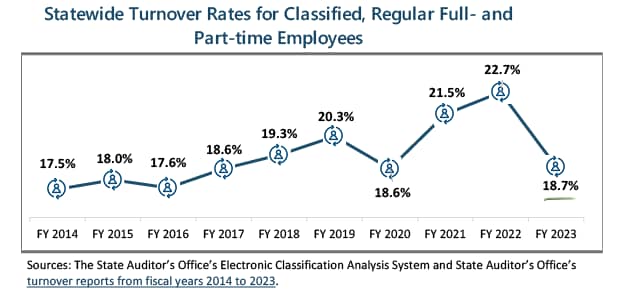
Here’s how Texas agencies serve you
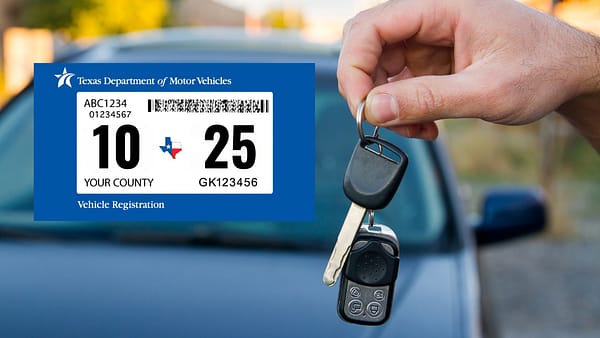
Whether you’re getting your driver’s license, registering your business, filing for unemployment benefits or just going for a drive along a state highway, you’re interacting with the state government.
- Driver’s Licenses: The Texas DPS processed 7.7 million driver’s license and ID transactions over the last 12 months, including renewals, replacements and new licenses.
- Voter Registrations: The Texas Secretary of State oversees voter registration, and as of 2024, Texas has 18 million registered voters.
- State Roads: The TxDOT maintains more than 80,000 miles of state roads, which includes highways and bridges across the state.
- State Parks: The TPWD oversees 89 state parks and historic sites, covering nearly 640,000 acres of land, ensuring conservation, recreation, and education.
More state agency facts and figures:
 819,000
819,000
The number of unemployment claims processed by the Texas Workforce Commission in 2023.
Unemployment figures can fluctuate month-to-month, depending on economic conditions and major events or storms.
 389,000
389,000
The average number of live births recorded annually by Texas Department of State Health Services from 2005-2021.
 110,000
110,000
The number of licensed attorneys registered with the State Bar of Texas, including both active and inactive members eligible to practice law within the state.
 3.9 million
3.9 million
The number of fishing and hunting licenses issued annually by TPWD.
-
-
-
- Did you know? The revenue generated from these licenses, along with an 11% excise tax on firearms and hunting gear, helps fund conservation efforts across the state.
-
-
How well do you know Texas’ state agencies?

